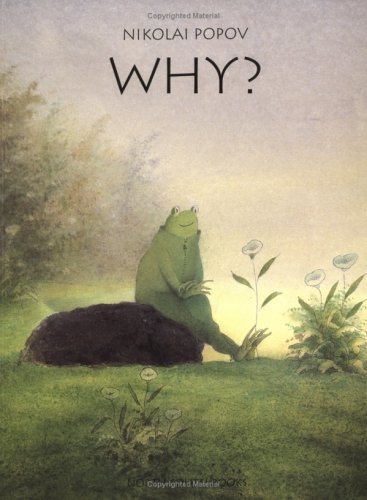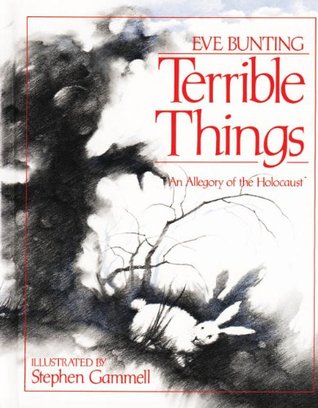 Cross-posted with Kidzone, because I would that everyone read both these books.
Cross-posted with Kidzone, because I would that everyone read both these books.
There are books that you don’t expect to gut you. Least of all when you’re browsing through the junior picture book section. But here are a couple that will do the job quite nicely, whenever you’re in the mood for it.*
Why? is propelled mercilessly forward until the end (as though inertia should apply to the plot of this book, except there is nothing to stop it because the plot isn’t physical and encounters no such impediments – though friction of a different sort you will encounter here, between the two sides), and all the while you’re desperately clinging onto the hope that perhaps Popov will spare us from the inevitable. Alas, Popov does not. (Or perhaps thankfully, because it tickles me pink to see that some picture books don’t shy away from a dash of reality, which can occasionally be dismal.) The colour palette reinforces the somber story as it progresses, the landscape becoming ever more torn. The suit that the frog is wearing also takes on a whole other possibility when we consider that this skin-like suit might have been rendered from… but I’ve said enough already. Beautifully illustrated and told, Why? should become a childhood staple.
And if you’ve already read Why?, then I’ve got something else to recommend you under the cut.
*Always in the mood to be gutted by a book. When is being gutted by a book not a good thing when it comes to visceral reactions to the written word? (I can actually think of a couple of instances.) Though not… physically gutted by a book. That’d just be brutal and I wouldn’t wish that on anyone.
 Terrible Things by Eve Bunting is the perfect follow-up to Why?, and serves well as an introduction to the Holocaust and helping children understand how atrocities can happen, slowly building up to their climax, without anyone noticing, or perhaps lifting a finger.* The white rabbit, which might be interpreted as a symbol for innocence and represent one that’s not touched by evil, does not live up to that expectation, in that it is unable to stop the community from grouping together against the Terrible Things (or perhaps unwilling to rock the boat too much in order to do the right thing). While the rabbit has its doubts and anxieties concerning the Terrible Things, it does not stop them, only asking its elders if this is really alright, and although the rabbit is not at all comforted by their telling it that this is the only way they will be left alone, in the end, it does not take action. Finally, only the rabbit survives because it realizes ahead of time what will happen, and resolves to warn the next community over so history never repeats itself again.
Terrible Things by Eve Bunting is the perfect follow-up to Why?, and serves well as an introduction to the Holocaust and helping children understand how atrocities can happen, slowly building up to their climax, without anyone noticing, or perhaps lifting a finger.* The white rabbit, which might be interpreted as a symbol for innocence and represent one that’s not touched by evil, does not live up to that expectation, in that it is unable to stop the community from grouping together against the Terrible Things (or perhaps unwilling to rock the boat too much in order to do the right thing). While the rabbit has its doubts and anxieties concerning the Terrible Things, it does not stop them, only asking its elders if this is really alright, and although the rabbit is not at all comforted by their telling it that this is the only way they will be left alone, in the end, it does not take action. Finally, only the rabbit survives because it realizes ahead of time what will happen, and resolves to warn the next community over so history never repeats itself again.
*See Milgram’s Obedience to Authority. There’s also Experimenter, which is a movie about Stanley Milgram’s story, available as a DVD and a Blu-ray.